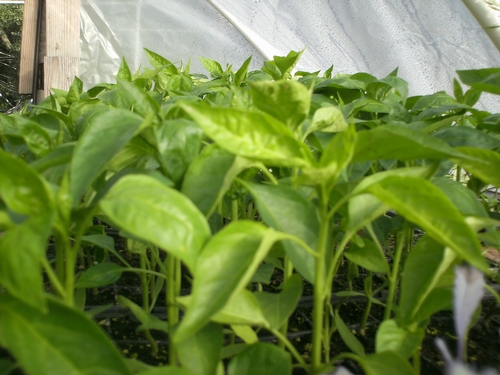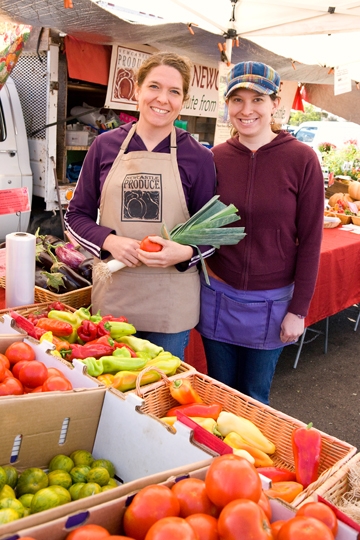Foothill Farming Blog
Winter Comes to Riverhill Farm
Morning comes late to our growing fields these days. Although we’ve passed the Winter Solstice and day length is increasing, the sun still follows a flat arc low across the southeastern sky, making for a prolonged twilight dawn of grays and blacks before the farm colors up with the rising sun.  The contrast between the areas of farm in shadow and those in brilliant winter light is accented by persistent frost which only disappears as the first rays of sun warm the soil.
The contrast between the areas of farm in shadow and those in brilliant winter light is accented by persistent frost which only disappears as the first rays of sun warm the soil.
The relative ease of winter work on the farm affords my wife, Jo, and me the time to take a morning cup of coffee outside on a sunny morning and watch the birds work for their food. We’re glad for the chance to spend some time watching others work.
I’m not sure whether you’d consider it the last act of last season or the first act of next, but before taking a much needed Fall break in December, we set about planting garlic for next summer. Down on our knees, we pushed the garlic cloves into the soil—8,000 times—knowing that each clove is to become a full head of garlic. Fall farming is like that: There’s comfort in the relaxed pace of planting, harvest more than eight months away. Working in the warm sun over the fragrant soil, lazy thoughts can find their own way without the pressure of a to-do list staring us down. In November, still working in t-shirts, it would have been unlikely for thoughts of winter  to intervene. We still owed our allegiance to summer. These days, the emerging garlic straps show up as green stripes in a field of snow.
to intervene. We still owed our allegiance to summer. These days, the emerging garlic straps show up as green stripes in a field of snow.
One of the great pleasures of winter on the farm comes with clear skies after snowfall. On a cold crisp morning before thaw, I wander around the fence lines following the tracks of all the creatures that use our fields for their own purposes during the night while we sleep. Bobcat, fox, raccoon and skunk all find their way in, either up one side of a wooden fence post and down the other, or through the wider openings in the woven wire. We build fence to exclude the herbivores—deer and rabbits—that might compete with us for the food we grow, but excluding the lesser predators can be an unintended and undesirable consequence of fencing. The persistence of these small predators in using our fields despite the fencing may account for the scarcity of gophers and ground squirrels we’ve had to contend with, critters that are the bane of many a farmers’ existence.
While digging a trench recently, I paused to catch my breath and noticed some fresh scat at the base of a fencepost. The scat was held together by short fur and small white bones--an owl’s signature, most likely. We’ve seen the Great Horned Owl working the fields at evening twilight and occasionally in the headlights of the truck as we drive in or out after dark. The bones and fur were not the only contents of the scat, however. A surprise was the partially  dismembered body of a Jerusalem Cricket. I occasionally unearth a Jerusalem Cricket while I’m digging around in the fields, especially while harvesting potatoes. Despite one of their common names—potato bug—they don’t eat potatoes, but they do burrow deeply during the day. Their habits above ground are mostly nocturnal, making them a likely target for an opportunistic owl.
dismembered body of a Jerusalem Cricket. I occasionally unearth a Jerusalem Cricket while I’m digging around in the fields, especially while harvesting potatoes. Despite one of their common names—potato bug—they don’t eat potatoes, but they do burrow deeply during the day. Their habits above ground are mostly nocturnal, making them a likely target for an opportunistic owl.
Predators from the surrounding woodland keep rodents in check, and pollinators such as the bumblebee, a ground dweller that depends on undisturbed soil for its burrows, work through our flowering crops and ensure the success of our harvest. Hungry wasps can be found wherever there are clusters of aphids, and countless beneficial insects find prey in our crops as well as nectar in our ornamental flowers. All this helps to make the farm a thriving ecosystem in its own right, but also serves to underscore our farm’s dependence on a healthy and diverse environment outside the farm fence.
We’ve come to understand these fields through observation and experience. We’ve borrowed them for our use from the surrounding woodland to satisfy our hometown’s need for food, but they work best when the separation between farm and woodland is as permeable as possible. There’s fallacy and perhaps some risk involved in thinking that thriving organic farms can exist as islands for the production of our healthful food while we disregard our responsibility to our rivers, forests and mountains beyond the farm gate.
Alan Haight, Riverhill Farm, Nevada City
Planning the year ahead
Ah winter, the season for a farmer to relax. Well not really. I like to use my “down time” to plan for the coming growing season. I find that the more carefully I plan, the happier I am once I get into the frantic just-trying-to-keep- up-with-things season. A plan gives me peace of mind because I know that I am not just plunging blindly ahead hoping that I will have enough produce to fill the Community Supported Agriculture (CSA) boxes and with any luck make some money this year.
I always start my planning process by figuring out how much I want to get paid for the work I do. No one should work for free and this goes for farmers, too. Many farmers work like crazy all season long and usually don’t pay themselves until the end of the year, all the while hoping that there will be some money left by the time they get to the end of the year. Don’t be one of these farmers. If you become one you will get discouraged and quit. So, make a plan to pay yourself and pay your expenses.
I like a very detailed plan that determines how much of each item to grow, what bed the crop will occupy, when to start seeds in the greenhouse, how many succession plantings to do, and on and on. The plan doesn’t have to be this detailed, but I find that the more details I cover the smoother the season runs and the less anxiety I have about meeting my commitments. There are many ways to plan your season: some farmers use pieces of paper and some use specialized spreadsheets that are available for purchase. No matter the format, the important part is that you have thought through the season and know where you are going.
Jim Muck, Jim's Produce, Wheatland
Opportunities for Getting Started in Farming
Welcome to the Fooothill Farming blog!
Our new website (http://ucanr.org/foothillfarming) has a lot to offer and will continue to expand as we add more information. If you have a question or you have information to share, please contact us at foothillfarming@gmail.com.
If you're interested in starting a small farm or ranch in the Sierra Nevada foothills, this is the time of year to start your quest. In January and February 2011, there are lots of options to learn about small-scale foothill farming and ranching.
If you are just starting to think about farming or ranching, the Beginning Farm Planning class will be useful for you. It's a two session class on January 11th and 13th in Auburn. For more information and to register, go to http://ucanr.org/beginning farm planning.
If you need to learn more about marketing, check out the Sierra CRAFT (Collaborative Regional Alliance for Farmer Training) Marketing and Value-added Workshop on Friday January 14th in Auburn. For more information and to register, go to http://ucanr.org/sierracraft marketing & value added
For lots of options to choose from, consider attending the PlacerGrown Farm Conference on February 5th. For more information and to register, go to http://ucanr.org/placergrownfarm conference
If you've already started farming or ranching but need help with making your business pay, consider the 6-week Farm Business Planning class starting on February 10th. Starting in January, check the UCCE Placer/Nevada website for information and registration.
http://ceplacer.ucdavis.edu/index.cfm
Another event to consider attending is the Nevada County Grown Sustainable Food and Farm Conference on January 22nd. More information at: http://www.nevadacountygrown.org/conference/
For more opportunities, check the Foothill Farming website regularly.




